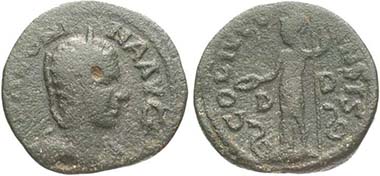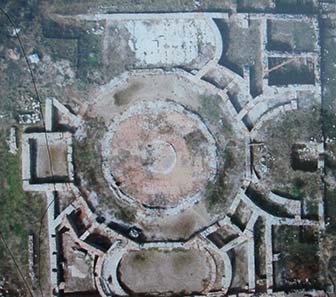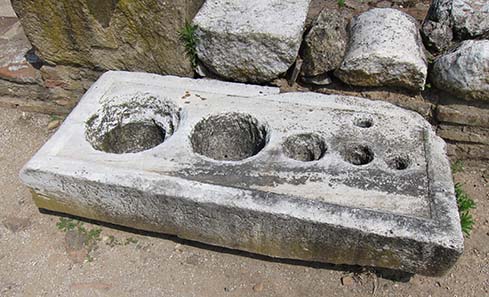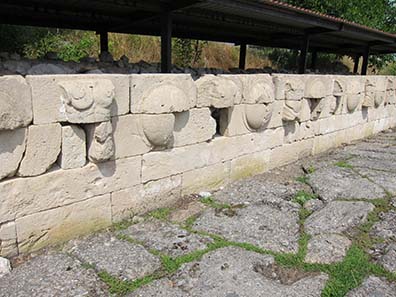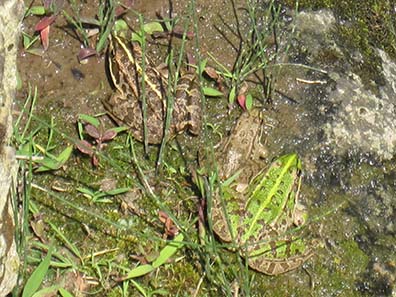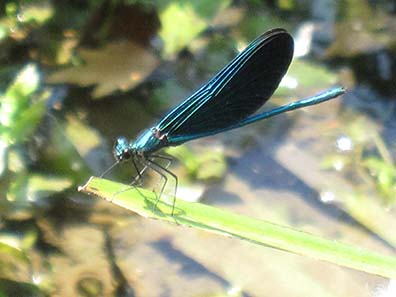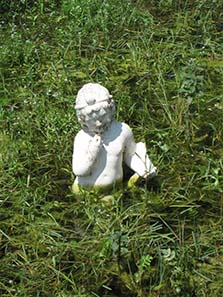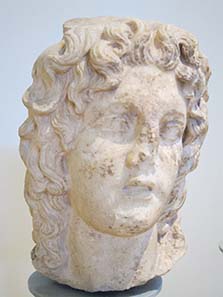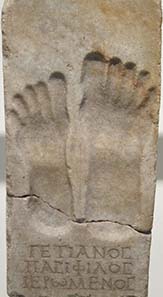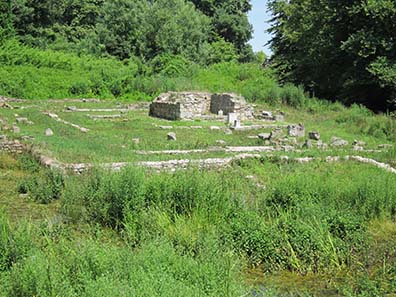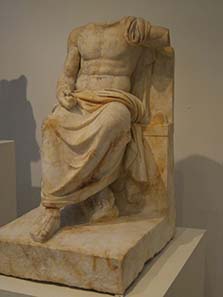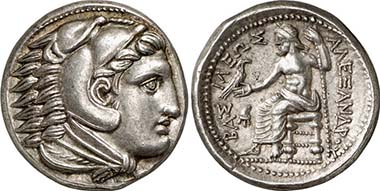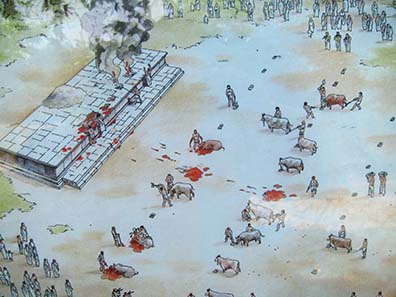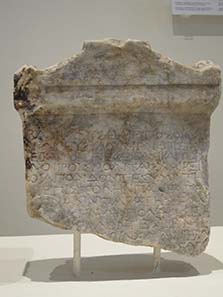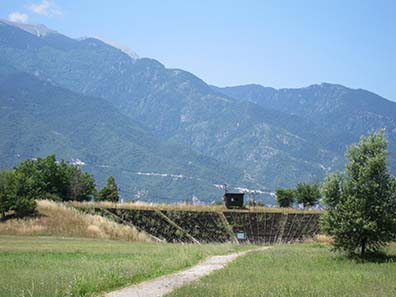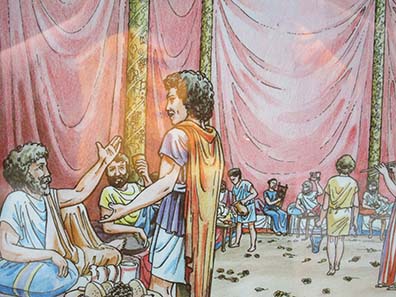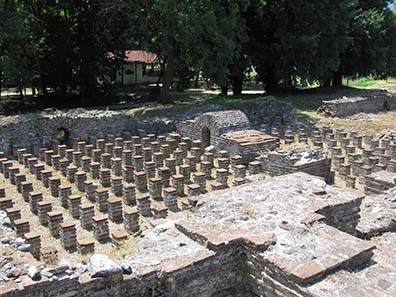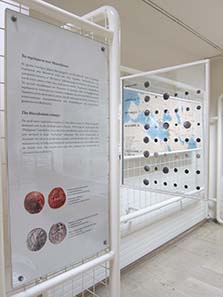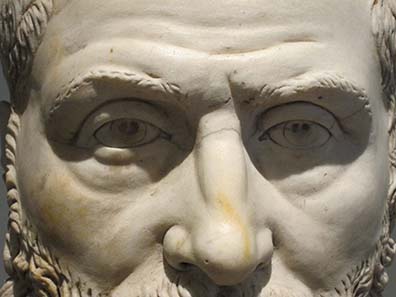by Ursula Kampmann
July 21, 2011 – The fifth stage of our journey is dedicated to Dion, perhaps the most beautiful excavation in Northern Greece. And Dion was important in antiquity: Alexander sacrificed to Zeus in Dion, before he set out to conquer the world…
Day 11, June 20, 2011, Camp site idyll in Platamon
Do you know the best way for a tourist to stay in Northern Greece? Look for a camp site. There are not only tents and caravans but, most of all, small apartment buildings where you can stay on the cheap but with all comfort possible. At present, two persons have to pay between 30 and 35 Euros.
Admittedly, one has to look after oneself but that is – when considering the ordinary hotel breakfast – more a relief than a problem. The rooms are comfortably spacious, are provided with air condition, a small kitchen with a big fridge and a gorgeous terrace.
Near Parga, we had found ourselves such a bungalow and did the same in Platamon now, a location visited mainly by Greeks and only a few Central Europeans eager for education until recently. In contrast to the Greeks who appreciate first and foremost the flat beach, many philhellenes make use of the place as starting point of trips to Macedonia and Thessaly.
The latter, however, have become almost impossible to come by. Perhaps the horrible pictures from Athens have scared many friends of Classical Greece off.
The gap has been filled by Bulgarians and, most of all, Serbians for whom it take only a little journey to spend a relatively inexpensive vacation here. There are, of course, culture-bound differences. The notion of noise, for example, is different, as is the dealing with children, especially with male ones. Whereas in Germany, after the anti-authoritarian stage, there is an increasing recognition of the fact that children need limits, here the youngsters skylark until midnight, shout and throw stones (sic! In our new quarters we were welcomed with a pigeon’s egg-sized pebble that just missed my head when being thrown into our room). In the apartment next to ours, a family with no male addition stayed. But wait, that isn’t true for the head of the family was a (male) baby of roughly one year of age an exciting grandma took meticulous care of. That little prince had discovered that the bars of the railing could be rotated thereby generating a great deal of squeaking – a sound which causes goosebumps, similar to fingernails scraping a blackboard. There was no chance of grandma making that sound stop. When we urgently asked her to do just that she shrugged and tried to talk the little one into dropping it. Oh yes, but the countless nightingales, which sing even during daylight, make you forget one or the other strange habit of foreign nations. Speaking of nightingales – they have a hell of a job when the little singing group begins singing Greek folk songs. The group members prefer the siesta for their conventions (because, you see, it is far too hot then for lying on the beach!).
It really is a fertile location for pursuing ethnological studies! If you are not patient enough for ethnology then we suggest that you stay away from camp sites at peak tourist season or to resort to a four star hotel;-)
I don’t want to omit mentioning that our campsite was very well-cared for. Many times I have talked with its owner about anything and everything (ranging from Greek history and archaeology to the current economical situation). It was always exciting, and we much enjoyed the famous Greek hospitality.
Day 12, June 21, 2011, Where Alexander sacrificed
Anyone who only knows the islands can’t imagine how difficult the mountains in Northern Greece can be. Nevertheless, every tourist has heard about the most famous mountain massiv of the country, Mount Olympus, where once upon a time the gods resided.
Just at the foot of the mountain, only a few kilometers away from the seashore, a city is situated that got its name from the father of gods, Dion.
Tourists are welcomed. Photograph: KW.
The city of Dion makes for a nice change to the disregard and neglect such ancient sites are faced with from local parties. Here, tourists are welcomed. This becomes apparent in many details, like the well-considered information boards and the parking lots turning the tourist’s visit of the excavation site and the museum into a joyful experience.
Plastered main street of Dion. Photograph: KW.
The Archaeological Park of Dion is open the entire day and has a magnificent infrastructure with a splendid axis. The first reporting about the remains of Dion was Leake, whose coin collection is housed in the Fitzwilliam Museum / Cambridge today. Since 1963, the University of Thessaloniki conducts archaeological excavations in Dion providing hundreds of students with the possibility of acquainting themselves with the practical side of excavating.
Dium (Macedonia). Salonina. Rev. Athena wearing a long garment surrounded by two snakes l. From auction Münzen und Medaillen GmbH 13 (2003), 83.
Dion most probably was founded by indigenous people. Around 700 B. C., it was conquered by Macedonians. It was the first big city of the Macedonians beyond the border of the Vale of Tempe. This is important since Dion thus automatically became the favorite place for the Macedon Kings to stage themselves as part of the Hellenistic world. That was why Dion was the most important religious center of Macedonia. Already Archelaos (413-399), in participation of celebrated delegations from the whole of Greece, instituted Olympian festivals. It was here where Philipp celebrated his triumph over Olynthos in 348; it was here where Alexander sacrificed before he departed to conquer the Persian Empire. Many writers have described the monument Alexander had Lysippus erected in Dion after the Battle at the Granicus River: it consisted of 25 equestrian statues of the comrades fallen in battle.
After the victory over the Macedonian Empire, the Romans founded in Dion a colony called Iulia Augusta Diensis of which a lavish coinage is extant. Since 346, the city was a bishop’s see, but then it faced its demise. The last cursory mention of Dion we find in the 10th century.
Aerial view of the agora on an explanatory panel. Photograph: KW.
When following the main street North, one arrives at the agora with its square layout measuring 60 x 60 meter. It architectonic structure only becomes clear in aerial view, as provided of all buildings by the explanatory panels.
Official measure of capacity of the city of Dion. Photograph: KW.
In the past, on the agora a marble block stood in which the official measures of capacity were inserted to come to a quick decision in an argument. Later, that stone was used to repair the pavement. Now, it had been transported back to the agora.
Along the main street. Photograph: KW.
In close vicinity, at the main street, there is a victory monument from the 4th cent. showing shields and armour.
View at the domestic quarter. Photograph: KW.
Repeatedly, one discovers picturesque vistas. Archaeology, however, almost plays second fiddle to the intriguing detail about Dion’s flora and fauna. You seen, Dion is so water-rich that the excavation had become a challenge. Time and again the Vaphyras had flooded the unearthed buildings. The modern visitor likewise has to find his way through mood or fordable water. In turn, he discovers any number of amphibians. We even saw snakes and turtles in Dion (although they refused posing for photographs).
Picture puzzle: how many frogs do you see? – You’ll find the solution at the end of the text. Photograph: KW.
Countless frogs we watched in Dion.
Dragonfly with beautiful blue-black wings. Photograph: KW.
And incredibly beautiful dragonflies with blue-black wings or of bright red color.
Sanctuary of Isis. Photograph: KW.
Outside the city area, the numerous sanctuaries of Dion are situated, like, for example, the one of Isis. It is splendidly preserved with all its temples and altars, colonnades for the visitors and lodgings for the priests.
Plaster cast of the statue of Harpokrates in the Sanctuary of Isis. Photograph: KW.
In antiquity, the river bed naturally didn’t run though the temple! It was situated a bit more to the East. Today, the combination of ruins and water appears incredibly romantic.
River God Vaphyras. Photograph: KW.
Vaphyras, being navigable in antiquity and hence providing a splendid way for the transport of goods, is connected with an enchanting myth: above, at the foot of Mount Olympus, musician Orpheus allegedly was mauled by franzied female followers. When, after the deed, they tried to cleanse their hands in the Vaphyras, the river was so appalled at this outrage that he disappeared in the ground to show up again at Dion. This is how the Greeks explained the phenomenon of the water sweeping away in the gravel bed of a chasm and re-appearing at the springs of Dion.
Foot prints in honor of Isis. Photograph: KW.
The Sanctuary of Isis is clearly identified thanks to numerous inscriptions and finds. Particularly interesting are the many stones with foot prints which may well represent votives symbolizing the many steps a pilgrim has to make in order to reach Isis.
Sanctuary of Zeus Hypsistos. Photograph: KW.
It was only recently that a second sanctuary for Zeus was discovered. It is devoted to Zeus Hypsistos.
Cult statue of Zeus Hypsistos. Photograph: KW.
His cult statue can be marveled at in the Museum of Dion today.
Alexander III. Tetradrachm, Amphipolis, 323-317. Head of Herakles. Rev. Zeus sitting l. Price 112. From auction LHS 102 (2008), 142.
Zeus not only played a vital role for Dion but in the coinage of Philipp (on the obverse) and Alexander (on the reverse) as well.
Foundations of the Sanctuary of Zeus Olympios. Photograph: KW.
The Sanctuary of Zeus Olympus was situated in greater distance of the city.
Reconstruction of the sacrifice for Zeus Olympios. Photograph: KW.
The explanatory panels offer a suggestion as to how a sacrifice might have been performed.
Letter of Philipp V to the citizens and officials of Dion. Photograph: KW.
During the Social War (220-217), the Aetolians destroyed the sanctuary. They pulled the statues of the Macedon Kings from their bases and shattered the inscriptions. Present-day archaeologists appreciate their efforts – after all, as part of the clearing operations, the Macedonians buried the useless parts in shafts which provide their material to science centuries later.
Hellenistic Theater of Dion. Photograph: KW.
Dion is particularly proud of the Hellenistic Theater that is dated to the early 4th century after coins finds. Renowned poet Euripides, however, stayed at the court of Archelaos I from 408 until his death in 406. And hence ‘it is improbable that this is the very location of the – possibly smaller – theater where the tragedies were staged Euripides has written in Macedonia, i.e. Archelaos and Bacchae.’, as we are told by the small guidebook of D. Pandermalis.
Reconstruction of the festivity prior to the departure of Alexander III. Photograph: KW.
Apart from that, researchers locate the marquee here where Alexander held the big ceremonies prior to the departure to Asia.
Hypocaust system of the Roman Baths. Photograph: KW.
Not to forget the Roman Baths with everything preserved that belonged to baths: hypocaust system, public toilets, Odeon….
Mosaic from the Roman Baths. Photograph: KW.
…and the stupidest looking bull ever.
Museum with the Dion finds. Photograph: KW.
No visitor of the site ought to miss visiting the museum with the finds of Dion.
The museum educational department of the Museum of Dion. Photograph: KW.
It has a carefully designed museum educational department in the basement. I was especially impressed by an assembling of all tools necessary to work on stones and statues with an allocated face with processing marks each.
Exhibition of coins in the Museum of Dion. Photograph: KW.
The coins can be found as well in the basement of the Dion museum. They are put in rotatable racks made of Perspex with holes cut out to accomodate them. Admittedly, the presentation leaves something to be desired. Many pieces are presented upside-down and lack a description, but, at least, some fractions are magnified.
Detail of a herm with the portrait of Herennianos. Photograph: KW.
Let’s conclude the eventful day with some of the outstanding objects of the Museum of Dion, like this detail of the magnificent head of Herennianos made in the early 3rd cent. A. D.
Head of Severus Alexander. Photograph: KW.
A bronze head of Severus Alexander (222-235) dates to roughly the same time. It was discovered not in Dion but in neighboring Ryakia.
Hydraulis. Photograph: KW.
The most valuable exhibit is the hydraulis which was unearthed in 1992; this musical instrument was to become the predecessor of the modern organ. Being made in the 1st cent. B. C., it is the most ancient specimen of this instrument known to exist. It consists of 27 bronze pipes of different height air was pressured through, as well as the plates which fixed them.
The visit of Dion ranged amongst the highlights of our voyage so far. Admittedly, there is much more gold and mise-en-scène to be viewed in Vergina, but Dion took us much closer to Macedonian history and the daily life of the citizens of this country.
By the way, anyone visiting the Museum of Dion ought to have a look at the museum shop. Nicely done replicas made of cast stone can be found here, available at reasonable prices. Apart from that, there are official coin replicas of pieces most collectors can’t afford: Naxos (island), Seriphos or Melos. The price tag of 40 Euros, however, I found a bit too big, when compared with the artificial stones.
PS. Here comes the solution of our picture puzzle: the frogs are three in number.
If you would like to accompany us on our trip to Mount Olympus and Thessaly don’t miss the next issue of the “Numismatic diary“.
You can read all other parts of this diary here.







